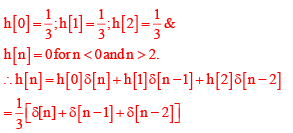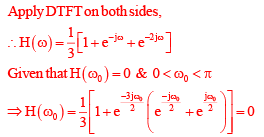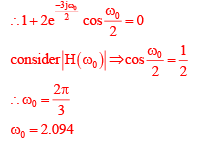Electronics and Communication Engineering (ECE) Exam > Electronics and Communication Engineering (ECE) Questions > Let h[n] be the impulse response of a discret...
Start Learning for Free
Let h[n] be the impulse response of a discrete-time linear time invariant (LTI) filter. The impulse response is given by

Let H (ω) be the discrete-time Fourier system transform (DTFT) of h[n], where ω is the normalized angular frequency in radians. Given that H (ω0) = 0 and 0 < ω0 < π, the value of ω0 (in radians) is equal to __________.
Let H (ω) be the discrete-time Fourier system transform (DTFT) of h[n], where ω is the normalized angular frequency in radians. Given that H (ω0) = 0 and 0 < ω0 < π, the value of ω0 (in radians) is equal to __________.
Correct answer is '2.05 to 2.15'. Can you explain this answer?
| FREE This question is part of | Download PDF Attempt this Test |
Verified Answer
Let h[n] be the impulse response of a discrete-time linear time invari...
It is given that,




|
Explore Courses for Electronics and Communication Engineering (ECE) exam
|

|
Similar Electronics and Communication Engineering (ECE) Doubts
Let h[n] be the impulse response of a discrete-time linear time invariant (LTI) filter. The impulse response is given byLet H (ω) be the discrete-time Fourier system transform (DTFT) of h[n], where ω is the normalized angular frequency in radians. Given that H (ω0) = 0 and 0 < ω0 < π, the value ofω0 (in radians) is equal to __________.Correct answer is '2.05 to 2.15'. Can you explain this answer?
Question Description
Let h[n] be the impulse response of a discrete-time linear time invariant (LTI) filter. The impulse response is given byLet H (ω) be the discrete-time Fourier system transform (DTFT) of h[n], where ω is the normalized angular frequency in radians. Given that H (ω0) = 0 and 0 < ω0 < π, the value ofω0 (in radians) is equal to __________.Correct answer is '2.05 to 2.15'. Can you explain this answer? for Electronics and Communication Engineering (ECE) 2024 is part of Electronics and Communication Engineering (ECE) preparation. The Question and answers have been prepared according to the Electronics and Communication Engineering (ECE) exam syllabus. Information about Let h[n] be the impulse response of a discrete-time linear time invariant (LTI) filter. The impulse response is given byLet H (ω) be the discrete-time Fourier system transform (DTFT) of h[n], where ω is the normalized angular frequency in radians. Given that H (ω0) = 0 and 0 < ω0 < π, the value ofω0 (in radians) is equal to __________.Correct answer is '2.05 to 2.15'. Can you explain this answer? covers all topics & solutions for Electronics and Communication Engineering (ECE) 2024 Exam. Find important definitions, questions, meanings, examples, exercises and tests below for Let h[n] be the impulse response of a discrete-time linear time invariant (LTI) filter. The impulse response is given byLet H (ω) be the discrete-time Fourier system transform (DTFT) of h[n], where ω is the normalized angular frequency in radians. Given that H (ω0) = 0 and 0 < ω0 < π, the value ofω0 (in radians) is equal to __________.Correct answer is '2.05 to 2.15'. Can you explain this answer?.
Let h[n] be the impulse response of a discrete-time linear time invariant (LTI) filter. The impulse response is given byLet H (ω) be the discrete-time Fourier system transform (DTFT) of h[n], where ω is the normalized angular frequency in radians. Given that H (ω0) = 0 and 0 < ω0 < π, the value ofω0 (in radians) is equal to __________.Correct answer is '2.05 to 2.15'. Can you explain this answer? for Electronics and Communication Engineering (ECE) 2024 is part of Electronics and Communication Engineering (ECE) preparation. The Question and answers have been prepared according to the Electronics and Communication Engineering (ECE) exam syllabus. Information about Let h[n] be the impulse response of a discrete-time linear time invariant (LTI) filter. The impulse response is given byLet H (ω) be the discrete-time Fourier system transform (DTFT) of h[n], where ω is the normalized angular frequency in radians. Given that H (ω0) = 0 and 0 < ω0 < π, the value ofω0 (in radians) is equal to __________.Correct answer is '2.05 to 2.15'. Can you explain this answer? covers all topics & solutions for Electronics and Communication Engineering (ECE) 2024 Exam. Find important definitions, questions, meanings, examples, exercises and tests below for Let h[n] be the impulse response of a discrete-time linear time invariant (LTI) filter. The impulse response is given byLet H (ω) be the discrete-time Fourier system transform (DTFT) of h[n], where ω is the normalized angular frequency in radians. Given that H (ω0) = 0 and 0 < ω0 < π, the value ofω0 (in radians) is equal to __________.Correct answer is '2.05 to 2.15'. Can you explain this answer?.
Solutions for Let h[n] be the impulse response of a discrete-time linear time invariant (LTI) filter. The impulse response is given byLet H (ω) be the discrete-time Fourier system transform (DTFT) of h[n], where ω is the normalized angular frequency in radians. Given that H (ω0) = 0 and 0 < ω0 < π, the value ofω0 (in radians) is equal to __________.Correct answer is '2.05 to 2.15'. Can you explain this answer? in English & in Hindi are available as part of our courses for Electronics and Communication Engineering (ECE).
Download more important topics, notes, lectures and mock test series for Electronics and Communication Engineering (ECE) Exam by signing up for free.
Here you can find the meaning of Let h[n] be the impulse response of a discrete-time linear time invariant (LTI) filter. The impulse response is given byLet H (ω) be the discrete-time Fourier system transform (DTFT) of h[n], where ω is the normalized angular frequency in radians. Given that H (ω0) = 0 and 0 < ω0 < π, the value ofω0 (in radians) is equal to __________.Correct answer is '2.05 to 2.15'. Can you explain this answer? defined & explained in the simplest way possible. Besides giving the explanation of
Let h[n] be the impulse response of a discrete-time linear time invariant (LTI) filter. The impulse response is given byLet H (ω) be the discrete-time Fourier system transform (DTFT) of h[n], where ω is the normalized angular frequency in radians. Given that H (ω0) = 0 and 0 < ω0 < π, the value ofω0 (in radians) is equal to __________.Correct answer is '2.05 to 2.15'. Can you explain this answer?, a detailed solution for Let h[n] be the impulse response of a discrete-time linear time invariant (LTI) filter. The impulse response is given byLet H (ω) be the discrete-time Fourier system transform (DTFT) of h[n], where ω is the normalized angular frequency in radians. Given that H (ω0) = 0 and 0 < ω0 < π, the value ofω0 (in radians) is equal to __________.Correct answer is '2.05 to 2.15'. Can you explain this answer? has been provided alongside types of Let h[n] be the impulse response of a discrete-time linear time invariant (LTI) filter. The impulse response is given byLet H (ω) be the discrete-time Fourier system transform (DTFT) of h[n], where ω is the normalized angular frequency in radians. Given that H (ω0) = 0 and 0 < ω0 < π, the value ofω0 (in radians) is equal to __________.Correct answer is '2.05 to 2.15'. Can you explain this answer? theory, EduRev gives you an
ample number of questions to practice Let h[n] be the impulse response of a discrete-time linear time invariant (LTI) filter. The impulse response is given byLet H (ω) be the discrete-time Fourier system transform (DTFT) of h[n], where ω is the normalized angular frequency in radians. Given that H (ω0) = 0 and 0 < ω0 < π, the value ofω0 (in radians) is equal to __________.Correct answer is '2.05 to 2.15'. Can you explain this answer? tests, examples and also practice Electronics and Communication Engineering (ECE) tests.

|
Explore Courses for Electronics and Communication Engineering (ECE) exam
|

|
Suggested Free Tests
Signup for Free!
Signup to see your scores go up within 7 days! Learn & Practice with 1000+ FREE Notes, Videos & Tests.























